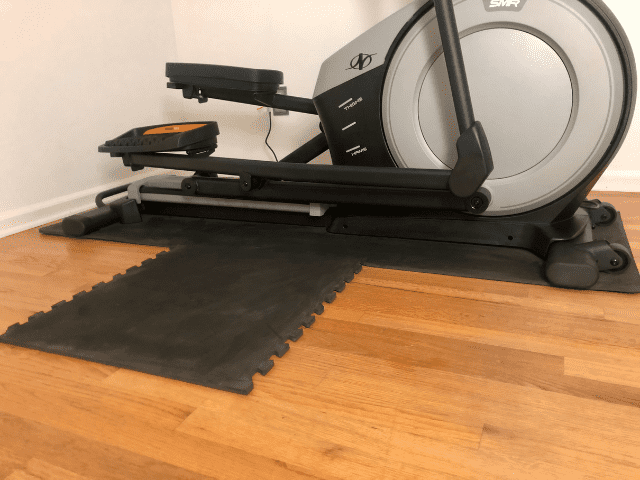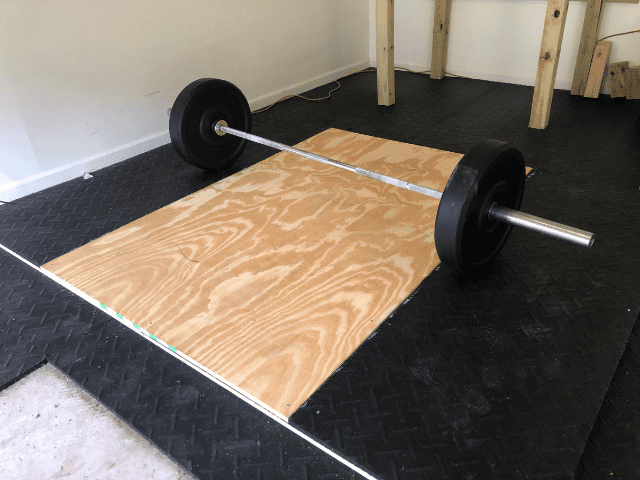How Thick Should Gym Flooring Be? (and what material)
Gym flooring is an essential component for every home gym. Whether it’s a thinner foam floor or a thick, durable rubber floor – every gym needs protection for both the floor underneath as well as for the equipment if you’re on a hard concrete floor like a garage floor.
Gym flooring thickness should be between 3/8″ and 3/4″ of an inch. The thickness for every home gym will depend on the activities that will be done on it. Flooring material will also play a big factor in the thickness needed as well.
The thickness that’s going to work best for your gym will be much different depending on what you’re planning to do on it.
If all of your dumbbells are blue, green or orange, the gym floor you need will probably be much different than someone who is deadlifting 500 pounds.
Don’t worry, I’m going to break down each scenario and give you my advice on the best gym flooring based on your home gym needs.
But, before we start talking thickness specifics though, I have to talk about a very important aspect of gym flooring that will make a huge difference in the floor you end up. You see, all gym floor thicknesses are (literally) not built the same.
Links on this page may be affiliate links. If you make a purchase through these links I may, at no extra cost to you, earn a commission.
Gym Flooring: Rubber vs Foam
Almost all gym flooring is made from one of two materials – rubber and foam.
Rubber gym flooring can come in the form of rubber mats, tiles and in rolls. Foam gym flooring is generally made from EVA Foam and predominantly comes in the form of interlocking tiles that look like puzzle pieces.
Rubber flooring is much denser and harder than foam flooring. Because of that, rubber flooring is much more durable and able to withstand much more wear and tear than foam flooring.
A thinner 3/8″ rubber floor will hold up to high intensity activities better than even a 1″ thick EVA Foam tile floor. I can’t emphasize enough how important it is to look at the material of the floor you’re considering purchasing.
Best Gym Floor Thickness For Light Activities

Light activities would include things like Yoga, Pilates, Bodyweight workouts, light dumbbells (about 20lbs or less) and resistance bands.
For low intensity type workouts, you can get by with a thinner rubber gym floor option. Or, this would be the only category where I think an EVA Foam tile floor, like this ProSource Tile Floor, would be sufficient.
If you do want to go with rubber flooring, something that is about 3/8″ thick would be perfect. This thickness will protect your floor, your equipment and will be much more pleasant to work out on than a concrete floor in the garage or a hardwood floor in a home gym.
You can find 3/8″ rubber flooring in mats, tiles or rolls. For this type of home gym, rolled mats are probably your best option. To give you an example, these rubber floor rolls from Power Systems are very cost-efficient, they look nice and you can customize the flecks of color sprinkled into rubber.
Best Gym Floor Thickness For Moderate Activities
I believe the majority of home gym owners fall into this category of moderate activities. Your home gym is most likely in your garage or your basement. You’re using the room for general weight lifting – squats, bench press, dumbbell exercises – and you probably have at least one piece of cardio equipment like a treadmill, rower, etc.
And while you’re well beyond the green 10-pound dumbbells, you’re also not exactly planning on competing in a powerlifting meet any time soon. Power cleans and jerks also don’t really appeal to you either.
If this sounds about right, then the foam flooring is no longer a viable option. If you buy it, it’s going to tear up sooner than later and you’re going to end up buying floor all over again.
So, it really just depends on the thickness of rubber flooring that will work best.
For this style of working out, I believe a 3/8″ rubber floor will still do the job as long as you’re careful about dropping weights on it.
If you are one who likes to err on the side of caution, I would suggest a 3/4″ rubber stall mat that I’m going to discuss in depth next.
Best Gym Floor Thickness For Heavy Activities

Do you love Olympic lifts? Heavy deadlifts with multiple plates on each side of the bar? CrossFit?
Then you need 3/4″ rubber mats for your gym flooring.
My suggestion for the best gym flooring (and I have no affiliation with them) is Horse Stall Mats from Tractor Supply Company. This is the flooring that I have in my garage gym and I’m 100% happy with my decision.
First, they are thick and crazy durable. I have a friend who owns a sports performance facility. He’s still using the same stall mats that bought when he opened up his place a decade ago and they’re still in great shape.
Second, they’re cheap. There are other stall mats that you can buy, but tractor supply mats are sometimes less than half of the price of other rubber gym mats.
Now, are they perfect, no? The biggest drawback to horse stall mats is they are going to smell horrid when you first bring them home. The smell won’t last and there are ways to expedite the process of making the smell go away, but just be prepared – it’s not pleasant the first week or two.
Finally, if you are going to be doing a lot of Olympic lifting where you’re dropping snatches, cleans and jerks quite a bit, I would go one step further and get a platform.
Whether you buy one or build one (they’re surprisingly easy to build), it will give your floor an extra layer of protection from the onslaught of dropped bumper plates.
Final Thoughts
Getting the proper gym flooring based on the needs of your home gym is a critical step toward making sure you’re protecting both your floor and your equipment. After all, all of this gym equipment you’re buying – barbells, dumbbells, plates, etc – isn’t exactly cheap and you want to take care of them.
Making the right decision on the type of gym floor and the thickness of the floor is also important because gym flooring is too expensive to have to buy twice and moving all of that equipment once the floor is laid is no fun either.
I hope this article helped you in your decision process to figure out the best thickness of gym flooring for your own gym.
Stay Strong!

